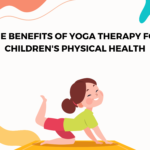Introduction
Yoga therapy is an increasingly popular form of complementary and alternative medicine that is becoming more widely recognized for its many health benefits. While most people think of yoga as a practice that only adults engage in, it can also be a valuable tool for improving the physical health of children. Yoga therapy involves the use of yoga practices such as asanas (poses), pranayama (breathing exercises), and meditation to help children improve their physical and mental health. In this blog post, we will explore the many physical health benefits of yoga therapy for children, including improved flexibility, increased strength, better balance and coordination, enhanced immune function, and improved respiratory function.
Improved Flexibility and Range of Motion
Improved flexibility and range of motion is one of the primary physical health benefits of yoga therapy for children. Yoga poses involve gentle stretching and movement that can help increase a child’s flexibility and range of motion. This can be particularly beneficial for children who are involved in sports or physical activities that require a lot of movement.
By improving their flexibility, children can reduce their risk of injury and improve their overall physical performance. Additionally, yoga poses can also help children develop better body awareness and posture, which can be particularly beneficial for those who spend a lot of time sitting in front of screens or carrying heavy backpacks.
Some examples of yoga poses that can help improve flexibility and range of motion include downward-facing dog, cat-cow pose, and seated forward fold.
Increased Strength
Another important physical health benefit of yoga therapy for children is increased strength. Yoga poses require children to engage their muscles in new and challenging ways, helping to build strength throughout the body.
This can be especially beneficial for children who may be experiencing muscle weakness or those who are looking to improve their physical performance in sports or other physical activities.
Additionally, improved strength can also help children maintain better posture, reducing the risk of back pain and other musculoskeletal problems. Some examples of yoga poses that can help increase strength in children include plank pose, warrior pose, and boat pose.
Improved Balance and Coordination
Yoga therapy can also enhance immune function in children, which is an important physical health benefit. Studies have shown that practicing yoga can increase the production of immune cells in the body, improving the body’s ability to fight off infections and diseases.
Additionally, yoga can also help reduce inflammation in the body, which is linked to a range of chronic health conditions. This can be particularly beneficial for children who may be susceptible to frequent illnesses or those who have chronic health conditions.
Some examples of yoga practices that can help enhance immune function in children include pranayama (breathing exercises) and meditation, which can help reduce stress and boost overall wellbeing.
Enhanced Immune Function
Improved respiratory function is another significant physical health benefit of yoga therapy for children. Yoga poses and breathing exercises can help children develop better breathing habits, which can improve lung capacity and oxygenation throughout the body.
This can be particularly beneficial for children who may be dealing with respiratory issues such as asthma or allergies. Additionally, better respiratory function can also improve athletic performance and reduce the risk of fatigue during physical activity.
Some examples of yoga practices that can help improve respiratory function in children include pranayama exercises such as deep breathing and alternate nostril breathing, as well as yoga poses that focus on expanding the chest and improving lung capacity.
Improved Respiratory Function
Yoga therapy can also have a positive impact on children’s respiratory function, which is essential for maintaining good physical health. Breathing exercises and yoga poses that focus on deep breathing can help children strengthen their respiratory muscles, increase lung capacity, and improve overall oxygenation of the body.
This can be particularly beneficial for children who experience respiratory issues such as asthma or allergies, as well as those who are involved in sports or other physical activities.
In addition to improving respiratory function, yoga therapy can also help children manage stress and anxiety, which can be contributing factors to respiratory problems. Some examples of yoga practices that can help improve respiratory function in children include diaphragmatic breathing, kapalabhati pranayama, and bridge pose
Conclusion
In conclusion, yoga therapy can be a valuable tool for improving the physical health of children. The various physical health benefits of yoga therapy, including improved flexibility, increased strength, better balance and coordination, enhanced immune function, and improved respiratory function, can all contribute to better overall physical health and wellbeing in children.
By engaging in yoga therapy practices such as asanas, pranayama, and meditation, children can develop better body awareness, reduce their risk of injury, and improve their physical performance. With regular practice, yoga therapy can help children build healthy habits that can contribute to a lifetime of good physical health.

